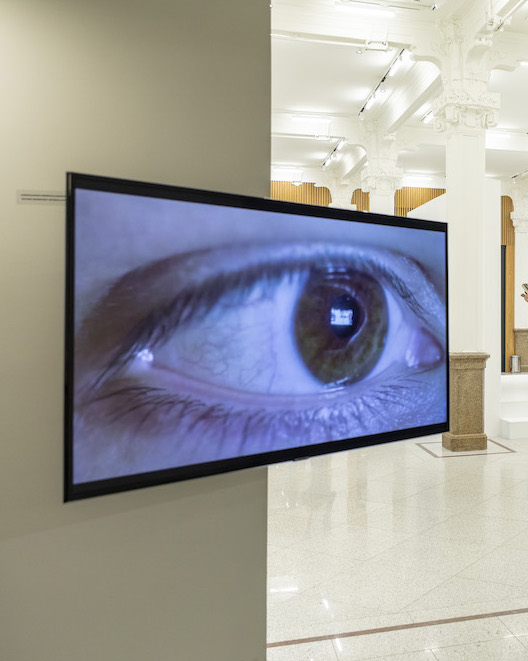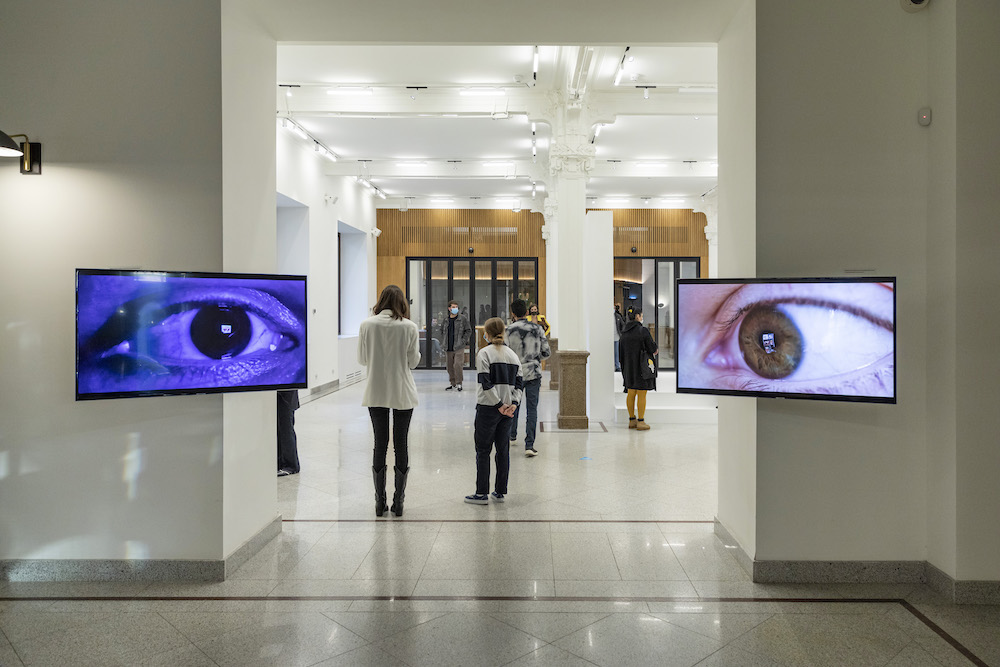
Feel free to add tags, names, dates or anything you are looking for


Over the past 30 years, the internet has reshaped and rearranged our communal understanding of the environment in the most diverse ways. This all-encompassing influence spans from labor to commodity, from everyday conversation to political negotiations, from the reproduction of meaning to simulated wars and catastrophes. When virtuality governs our everyday life, our main concern is whether it may become part of our perception. The group exhibition “Digital Natives,” which was opened on 28th of October in TBC Concept, and is curated by Nina Kintsurashvili, is attempting to highlight this topic and pose technological questions within a given cultural and social framework. The term “digital native” implies the generation that was raised in the era of technology and the internet. The notion was developed by John Perry Barlow in his critical letter: “A Declaration of the Independence of Cyberspace.” The exhibition aims to interpret the internet and digital aesthetics in a free and critical way.

The group exhibition “Digital Natives” 2021
On the first floor, in the main hall, we encounter Ana Ke and Florian Meisenberg’s installation “Countdown Bella Donna” (2017). Two large eyes installed in separate panels look out randomly. Sometime in the early 80s, Jean Baudrillard stated that the usage of technology had taken a strange reversal through its development: “We no longer watch TV,” he said, “TV watches us.”* And here, 40 years after Baudrillard’s prophecy, we see two eyes that are actually monitors observing the space in a somewhat psychotic fashion. Now this goes beyond Baudrillard’s analysis, and probably even signifies the satellite governance of technology over us. Technology has lost its center; instead it has become a “chaser.” It traces our movements in space and time. The technological gaze is everywhere. We might even speculate that our own gaze is being technologized.

The group exhibition “Digital Natives”.2021.Ana Ke and Florian Meisenberg’s installation “Countdown Bella Donna” 2017

The group exhibition “Digital Natives”.2021.Ana Ke and Florian Meisenberg’s installation “Countdown Bella Donna” 2017
Another work echoing this issue is Tezi Gabunia’s “Flooding of the Louvre,” which was presented on Facebook two years ago. A miniature model of a particular room at the Louvre was slowly submerged in water. The flooding was livestreamed to create the effect of a real catastrophe. The exhibited piece demonstrates the reactions of the audience through their comments, their astonishment and confusion while trying to figure out what was going on. The real and the fake cannot be distinguished. The artwork creates an ethical dilemma, and also underlines the characteristics of our times: the simulation of life at a microscopic level. From this point on, truth and lies become the same, the first collapsing in order to fulfill our virtual will – that of entertainment and catastrophe.

The group exhibition “Digital Natives”.2021. Tezi Gabunia’s “Flooding of the Louvre” 2016

The group exhibition “Digital Natives”.2021.Tezi Gabunia’s “Flooding of the Louvre” 2016
The diversity of the show flourishes when we see the hybrid painting by Tamo Jugeli “Half-Human, Half-Machine” (2021). Through the use of bright colors, sharp contrasts but soft layers and overlapping shapes, the painting transfers the memory of a hand through technological language. While usually the opposite occurs - the language of a painter is transferred to the memory of a computer, after which it improvises a purely mimetic ability. The work of Tamo Jugeli inverts this process. In the given piece, digital language is memorized by the painter and creates semi-automatic aesthetics. Thus a hybrid image is created as an alternative to the technological scenario.

The group exhibition “Digital Natives”.2021.Tamo Jugeli “Half-Human, Half-Machine” 2021

The group exhibition “Digital Natives”.2021.Tamo Jugeli “Half-Human, Half-Machine” 2021
There are two other pieces on the 1st floor, both reflecting on social media. Qeu Meparishvili’s project “Institute of Virginity,” and “Conscious Engine 2: absentblackfatherbot” by Bogosi Sekhukhuni. The first reflects on the issue of virginity among Georgian women by visualizing and vocalizing the narratives found on secret online groups, where women share details of their private lives.

The group exhibition “Digital Natives”.2021.Qeu Meparishvili’s project “Institute of Virginity”
Bogosi Sekhukhuni’s work also underlines a private conversation between father and son. One animation shows the artist himself, while the other portrays his father being far away from him. In fact, the video simulation is a montage of a Facebook conversation. Both works find individual solutions on how to present invisible and intimate communications through an audio-visual platform.

The group exhibition “Digital Natives”.2021.“Conscious Engine 2: absentblackfatherbot” by Bogosi Sekhukhuni

The group exhibition “Digital Natives”.2021.“Conscious Engine 2: absentblackfatherbot” by Bogosi Sekhukhuni
The exposition on the first floor can be likened to our perception. The well-lit space and separated artworks underline the transition of information through our minds. Such communication is real. Opposed to this, the second floor resembles an unconscious process, which pushes the events to exposure. The central topic here is war and apocalypse. The narratives are arranged according to these topics: wars in Central Asia, myths about the destruction of the world, and a post-apocalyptic vision installed on large panels. The arrangement of particular artworks is also noteworthy. Tamuna Gurgenidze's installation "Bless your souls, beautiful girls” (2021), revives her grandmother's photo-archive. The work is installed in an aquarium-like box, thus establishing a strong unconscious connection with the viewer. Water, in turn, is a symbol of perfection, of the flow of time. In the depth of the box is a photo processed in digital format. Through this gesture, digital art acquires a sense of ephemera. Accordingly, the question arises: can digital technology impact memory perception?

The group exhibition “Digital Natives”.2021.Tamuna Gurgenidze's installation "Bless your souls, beautiful girls” (2021)

The group exhibition “Digital Natives”.2021.Tamuna Gurgenidze's installation "Bless your souls, beautiful girls” (2021)
The work of the Austrian group "Total Refusal", "Circumventing the Circle of Death” (2019), is found with a projection similar to the shape of the moon’s reflection. It shows a war video game. In the game, the opposing parties inevitably open fire when approaching each other. This process is fully guided by an algorithm. The simulation emphasizes an ambiguous moment of the modern world. On the one hand, we are faced with negotiating parties that are in constant tension, and on the other hand - wars that are taking place in a simulated mode. In parallel, Nima Bahrehmand and Ramin Roshandal's video, “The Status of Pieta” (2019), depicts a war from the perspective of artificial intelligence. The images are blurry, but clearly show the anxiety and uncertainty of the population in this region, as if the entire population fades behind simulated wars.

The group exhibition “Digital Natives”.2021.The work of the Austrian group "Total Refusal", "Circumventing the Circle of Death” 2019

The group exhibition “Digital Natives”.2021.The work of the Austrian group "Total Refusal", "Circumventing the Circle of Death” 2019

The group exhibition “Digital Natives”.2021.Nima Bahrehmand and Ramin Roshandal's video, “The Status of Pieta” 2019

The group exhibition “Digital Natives”.2021.Bahrehmand and Ramin Roshandal's video, “The Status of Pieta” 2019

The group exhibition “Digital Natives”.2021."Disasters under the Sun” 2019 by John Rafman

The group exhibition “Digital Natives”.2021."Disasters under the Sun” 2019 by John Rafman

The group exhibition “Digital Natives”.2021."Disasters under the Sun” 2019 by John Rafman
In the collaborative piece by Nima Bahrehmand and Ramin Roshandel, "Walking on Sol” (2020) and in "Disasters under the Sun” (2019) by John Rafman, apocalyptic visions are developed in which digital language becomes the agent of myth translation. Particularly noteworthy in Rafman's installation are the elements of sensuality (the scale of the works, the cold, sharp colors, the play with lighting, weightlessness of the figures, etc.), which engulfs the body of the viewer through the narrative. In conclusion, we can say that "digital natives" (as a total work) distinguishes between two main aspects – the perception of media art and the internet. On the one hand, the processes that bring about critical impulses in the subconscious, and on the other hand, the means of acknowledging these impulses - of understanding them. The spectrum covered by the exhibition is quite extensive. Consequently, for the viewer as well, the most interesting thing is how deeply the layers of perception are covered by digital media. Those synthetic layers of consciousness that are yet to be discovered, studied and explored.